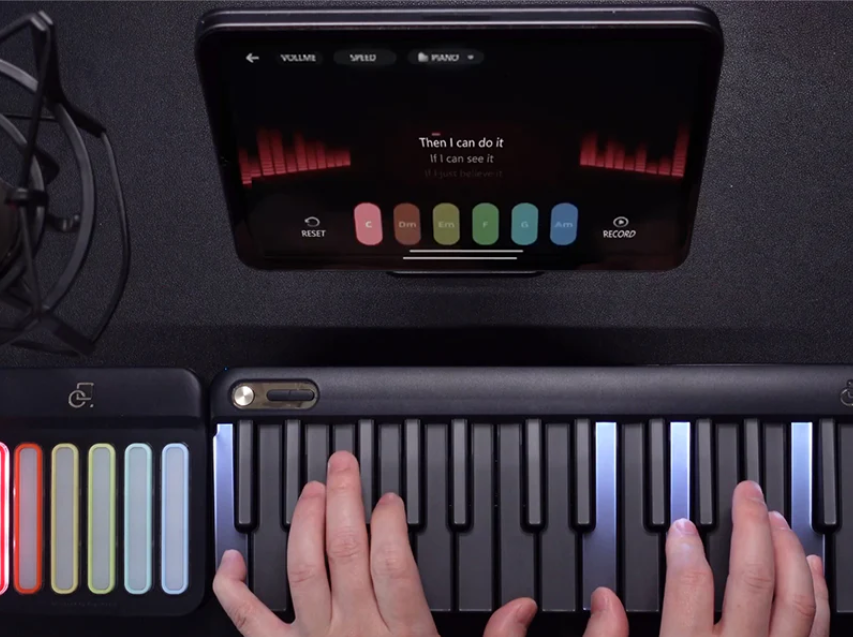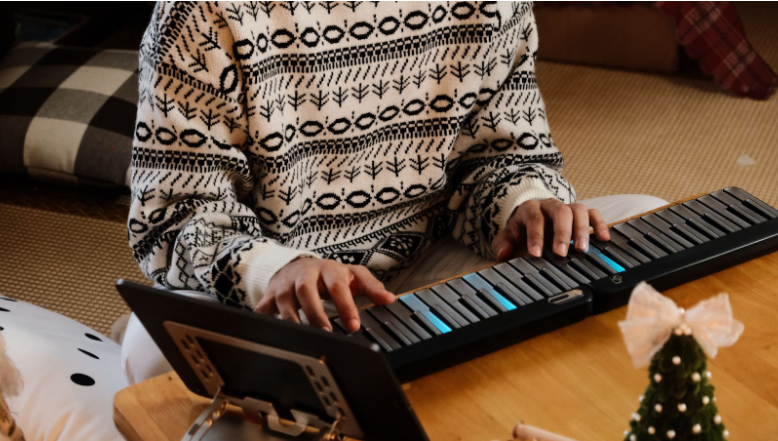
Scrolling through online music shops can feel like falling into a black hole of specs and sales banners. If your budget tops out at fifty dollars—and you’re hunting a first keyboard for yourself, the kids, or a cozy family jam—don’t sweat. Although full‑size digital pianos live in a pricier galaxy, the market still offers playful, capable options that punch well above their price tag.
This guide rounds up the best keyboards under $ 500 choices, explains why they’re worth the cart space, and shows when stretching slightly for a smart‑learning option such as the Smart Keyboard might make sense down the road.
|
Rank |
Model |
Keys |
Voices/Rhythms |
Typical Street Price* |
|
1 |
Yamaha PSS‑F30 |
37 mini |
120 / 114 |
$49 |
|
2 |
Casio SA‑46 |
32 mini |
100 / 50 |
$39 |
|
3 |
Alesis Harmony 32 |
32 mini |
300 / 300 |
$49–53 |
|
4 |
Alesis Melody 32 |
32 mini |
300 / 300 |
$35–45 (often on sale) |
|
5 |
Bigfun 37‑Key Kids Piano |
37 mini |
8 tones / 8 rhythms |
$26–32 |
|
6 |
Roll‑Up 61‑Key Silicone Piano |
61 flexible |
128 tones / 100 rhythms |
$28–45 |
|
7 |
Wendry 61‑Key Foldable |
61 flexible |
120 tones / 30 demos |
$28 |
|
8 |
Second‑Hand Wildcard |
Varies |
Varies |
<$50 on local listings |
Thirty or forty bucks won’t buy spruce soundboards or hammer action. What it will buy is a low‑risk foothold—something that lets you:
Will these boards carry you to Chopin? Probably not. But they’re perfect for sparking curiosity and building finger familiarity.
Yamaha squeezed a surprising 120 voices and 114 auto‑accompaniment styles into this 37‑key wonder. Mini keys fit little hands; a “Smart Chord” button turns single‑finger presses into full backing bands. The board runs on four AA batteries or USB power, so you can practice literally anywhere. At roughly one kilo, it’s lighter than most laptops. Yamaha Music And Musikhaus Thomann
Why we like it
Casio’s SA‑series has anchored the entry tier for decades, and the SA‑46 remains a crowd favorite. You get 32 mini keys, 100 tones, 50 rhythms, and a cheerful green‑and‑black chassis that survives kid chaos. Eight‑note polyphony isn’t much, yet single‑line melodies and chord drills sound fine. Street prices hover around $39, making it a true best 50 dollar keyboard. Amazon
Why we like it
Heads‑up: No sustain jack—practice pedals will need an upgrade later.
If you crave sound variety, Harmony 32 delivers 300 tones and 300 rhythms—more than some $200 boards. It also offers USB‑MIDI for app connectivity and a one‑eighth‑inch headphone jack. Prices flirt with our ceiling (often $49.99, occasionally inching up to $53), but the extra couple bucks buys a lot of sonic playground.
Why we like it
Melody 32 mirrors Harmony’s spec sheet but commonly ships with a mini mic, stickers, and trial lesson subscriptions. Deals as low as $39 pop up on Reverb or big‑box flash sales—watch those price trackers.
Why we like it
Sometimes you just want bright colors, drum pads, and a “demo” button that fires up instant dance tracks. Bigfun’s 37‑key toy scores on all counts while sliding under $30. It’s not meant for serious finger technique, but for household jam sessions it’s a blast.
Why we like it
Roll‑up pianos divide opinion, yet they’re unbeatable on portability. A typical 61‑key silicone mat weighs under two pounds, rolls into a tube, and includes 128 tones plus rhythm patterns. Prices range from $28 to $45, placing them securely in the keyboard under 50 bracket.
Why we like it
Wendry’s upgraded silicone roll‑up adds thicker key ridges, a metronome, and simple recording. It often lists at $28 on Walmart’s marketplace, making it the lowest‑priced 61‑key option that still offers MIDI compatibility.
Why we like it
Last but not least: the used market. Browse Craigslist, Facebook Marketplace, or local classifieds and you’ll find pre‑loved 49‑ or 61‑key boards from Yamaha’s PSR or Casio’s CTK series listed around $40‑$50—especially after holiday gift upgrades. Check key function, speaker output, and power supply before handing over cash.
Why we like it
|
Feature |
Mini Boards (Picks 1–5) |
Roll‑Ups (Picks 6–7) |
Second‑Hand Full Size |
|
Key Feel |
Hard plastic, mini width |
Soft silicone, no real travel |
Synth/semi‑weighted |
|
Sound Variety |
100–300 voices |
128 voices typical |
100–600 voices |
|
Portability |
Under 2 lbs, 20″ long |
Rolls to 5″ diameter |
8–15 lbs |
|
Power Options |
AA or USB‑C |
Rechargeable or AA |
AC adapter |
|
Learning Aids |
Metronome, demo songs |
Metronome, one‑finger chords |
May include lesson mode |
That’s where a smart keyboard piano like the Smart Keyboard shines. LED‑lit keys walk you through songs, gaming practice modes keep motivation sky‑high, and you can snap on an expansion board when you need more range—all while weighing under three pounds. Not under 50 bucks, true. But after testing the waters with one of the picks above, it’s an upgrade that feels natural rather than extravagant.
You’ll cover melody basics, finger numbers, and simple chords. Two‑octave songs fit fine. If you fall in love with piano, a 61‑key or smart keyboard expansion is the next move.
Most sub‑$50 models are not velocity‑sensitive. You’ll hear the same volume no matter how softly or firmly you press. Good enough for learning notes, not dynamics.
Very few musical keyboards under $50 include built‑in Bluetooth. For “best wireless keyboard under 50” bragging rights, pair a USB‑powered board with a phone‑sized power bank and a short OTG cable—no wall outlet required.
Grab a generic ¼‑inch sustain footswitch for $15‑20 (it looks like a small black pedal). Harmony 32, Melody 32, and many roll‑ups accept it.
On mini boards, roughly 6–8 hours of play. Rechargeable NiMH cells save money and the planet.
A tight budget shouldn’t fence you out of music. Whether it’s Yamaha’s polished PSS‑F30, Casio’s evergreen SA‑46, or a roll‑up piano that slides into a backpack, each keyboard under 50 in this list delivers just enough keys, sounds, and playful spirit to spark genuine musical momentum.
Nab the one that makes you smile, carve out ten minutes daily, and watch your fingers find their groove. Should the hobby stick, you’ll already have the muscle memory—and the excitement—to graduate to something like PopuPiano without hesitation. Honestly, that’s the best fifty bucks you’ll ever spend.
Read more

Cost of Learning Piano vs Using a Smart Keyboard
The dream is simple: sit at the keys, play your favorite song, feel that goose‑bump little rush. The question that stops many beginners cold is how much that dream is going to cost. Should you buy ...

Best 88-Key Weighted Keyboards for Beginners in 2025: Full Guide + Top Picks
Learning piano on a full‑sized, weighted keyboard feels wonderfully close to an acoustic instrument—you get the same span, the same resistance under your fingertips, and the same “Yes, I’m really d...